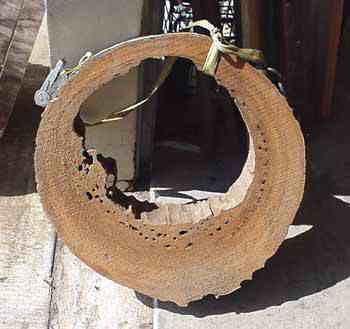Drying Large Rounds - Preventing Splitting
Other Versions
Spanish
Is it possible to dry these without problems? October 20, 2003
Question
I have rounds that I need to dry without splitting, but I don't want to invent the wheel if I don't have to. The rounds will come from green ponderosa pine and will be 4-5 inches thick and up to 48 inches in diameter. Does anyone have hands-on experience with preserving rounds in PEG (Pentacryl)? Are there better ways?
Forum Responses
(Sawing and Drying Forum)
I was told a long time ago that you couldn't treat wood discs that thick with PEG and get the process to work, and that you would have to soak the wood in the PEG solution for up to a year or more to assure enough penetration in the fresh wood cell walls (and even then not know if it was a long enough soak until the piece was dried without checking).
I am trying roughly the same thing, in cypress. The bowl turners use a dish soap and water solution when they turn bowls. Claim the bowls may dry out of shape, but rarely crack??
A dish soap solution does the trick. I have seen it myself. Have no idea how it would work for a huge round, but it's sure cheaper than
PEG.
To dry rounds without splitting, you will have "to invent the wheel." There are ways to minimize the cracking, such as using
PEG or other treatments. There are ways to hide the cracks, such as cutting into quarters and then gluing together after drying. However, there are no ways to stop shrinkage and the resultant cracks. Note that a turned bowl can shrink without cracking only because it is no longer a flat disc and even then it has to distort to dry.
All the treatments such as dish soap and water or PEG just prolong the drying process. It does not stop the process nor does it stop the cracking or distorting.
I have tried the soap on pieces 1 1/2 thick, rough turned bowls, and it did not work for me. Thin bowls do work.
We have had success with preventing log slices from cracking by drilling a hole in the pith of the heart. It allows the wood to shrink with some relief in the center. I know this will not work for turning blanks but if you are just trying to save the round it should.
Is this hole about right?

Dry several disks and put a kerf (bark to pith) in each one in a different location. Then when dry, use one of the disks for a source of pie-shaped pieces; from the main disks, cut out any splits (use a piece shape) and put a new piece from the special disk into the hole.
Gene Wengert, forum technical advisor
To preserve (hardwood) discs I am doing the following: first cut them at about a 70 degree angle to the heart so the annual rings are not completely concentric. Then I seal them almost completely leaving the centermost rings unsealed. Slow dry, removing a little of the sealer from the center out occasionally. Sometimes you will get more small checks, but fewer monster checks. Also, wood should be seasoned on the log at least one year.
Did you know that disks can also be buried in fresh manure for a few months and will dry out without much cracking?
Gene Wengert, forum technical advisor
The comments below were added after this Forum discussion was archived as a Knowledge Base article (add your comment).
Comment from contributor R:
I attended a Woodworkers Show that featured Steve Russel, woodturner. He has been doing extensive testing to reduce spitting of green turnings. He boils his initially turned bowl stock for one hour per inch of thickness. Note: this means the water has to get to a rolling boil again with the wood in the water before the clock starts. He, along with multiple other woodturners, has reduced stock splitting by as much as 50%. The boiling water heats the lignum to allow it to realign to the existing shape of the reduced stock, thereby reducing internal stresses along with assisting the drying process.
